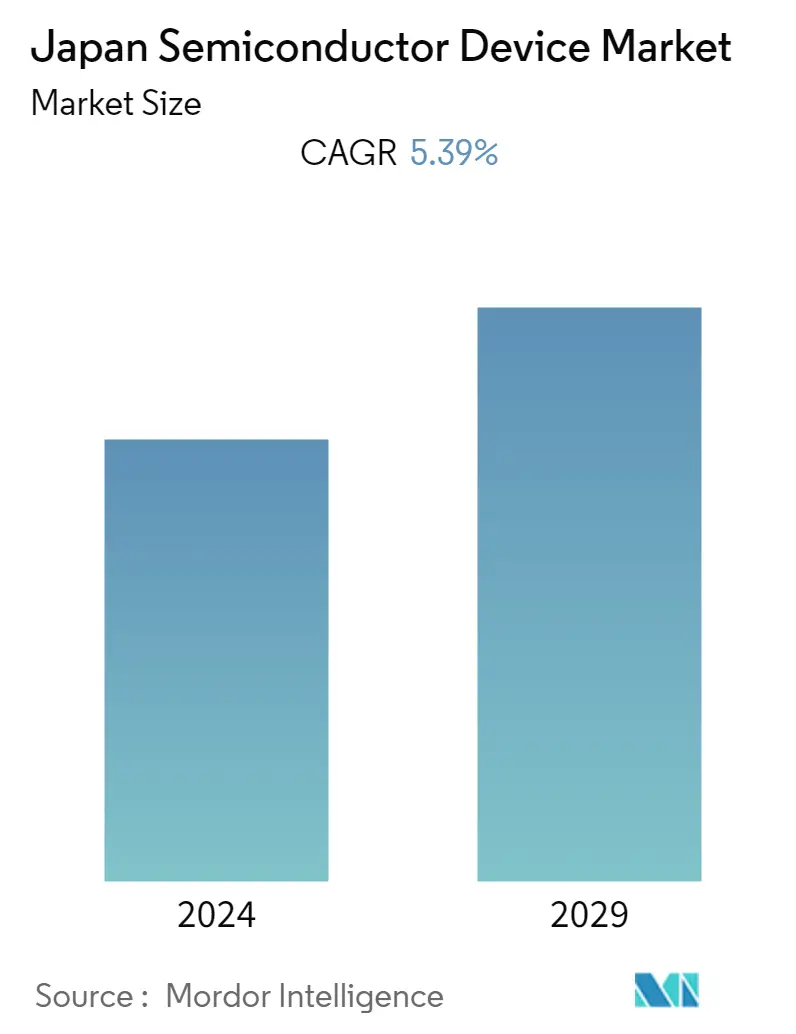Market Size of Japan Semiconductor Device Industry

| Study Period | 2019 - 2029 |
| Base Year For Estimation | 2023 |
| Forecast Data Period | 2024 - 2029 |
| Historical Data Period | 2019 - 2022 |
| CAGR | 5.39 % |
| Market Concentration | Low |
Major Players*Disclaimer: Major Players sorted in no particular order |
Need a report that reflects how COVID-19 has impacted this market and its growth?
Japan Semiconductor Device Market Analysis
The Japan semiconductor device market was valued at USD 47.72 billion during the current year and is anticipated to reach USD 65.38 billion by the end of the forecast period, registering a CAGR of 5.39% during the forecast period. The Japanese government is taking stringent measures to revive its industries, such as consumer electronics and automotive. Also, the government wishes to reduce the clustering of production facilities in one place to reduce production dependency on geographical constraints. In line with this, Japan announced a USD 2.2 billion stimulus package to help its manufacturers to shift their production facilities out of China as COVID-19 disrupted the supply chain. The package specifies USD 2 billion for companies shifting production back to Japan.
- The semiconductor industry is estimated to continue its robust growth during the forecast period to accommodate the increasing demand for semiconductor materials in emerging technologies, such as artificial intelligence (AI), autonomous driving, the Internet of Things, and 5G, coupled with competition among key players and consistent spending on R&D.
- By 2025, the semiconductor industry is set to experience significant benefits from the ongoing development and innovation in connectivity, communications, the automotive industry, and data centers. The increase in the consumption of electronic components used in the navigation of automobiles, safety, and infotainment further contributes to the growth of the semiconductor sector.
- Semiconductors are used extensively across electronic devices, such as smartphones, LED TVs, flat-screen monitors, and civil aerospace and military systems. The semiconductor industry is also likely to benefit from progress in biometrics capabilities. The growing demand for smartphones and technologically advanced products, such as wearable gadgets, etc., is also impacting the market's growth.
- The automation and electrification of automobiles have been driving increased demand for semiconductor wafers. Semiconductor ICs with varied functionalities are used in various automotive products, such as infotainment systems, navigation control, and collision detection systems. The inclusion of such features has an impact on automobile sales.
- Further, Data-heavy Internet of Things (IoT) devices represent another emerging market for the semiconductor industry. Industry 4.0 is one segment of industrial automation, and IoT also includes wearables, aviation, healthcare, smart homes, smart metering, smart farms, smart logistics, and more.
- Similarly, in August 2022, Toshiba Electronic Devices and Storage Corporation launched the TWxxNxxxC series, a third-generation silicon carbide (SiC) MOSFETs with low on-resistance and significantly reduced switching loss. The products reduce on-resistance per unit area (RDS(ON)A) by approximately 43%, allowing for an 80% reduction in the drain-source on-resistance gate-drain charge (RDS(ON) Qgd). This critical index represents the relationship between conduction loss and switching loss.
